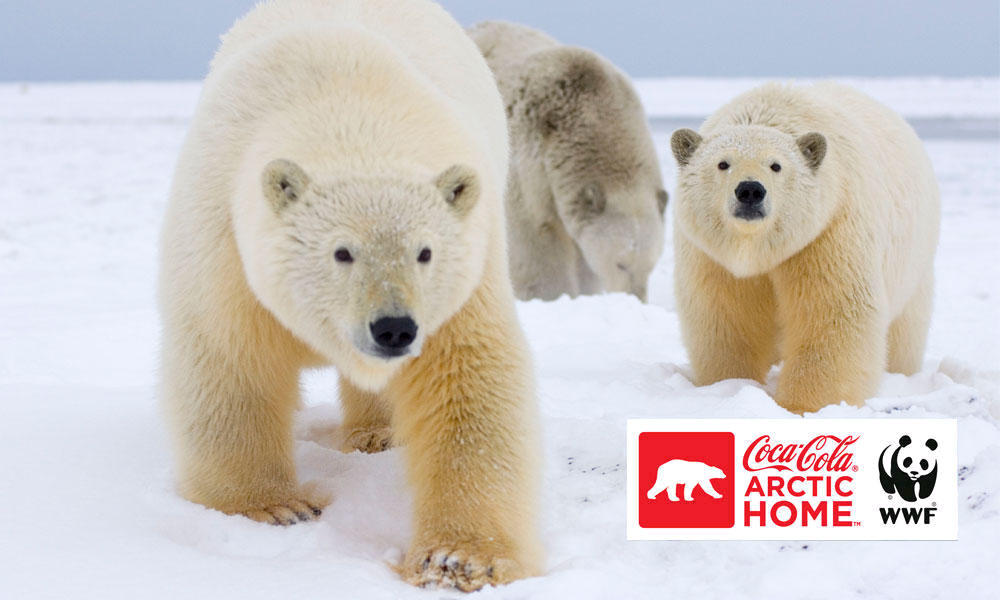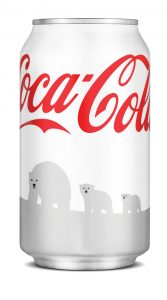Coca Cola and World Wildlife Fund Launch “Arctic Home” Campaign for Polar Bear Protection

WWF and The Coca-Cola Company Team Up to Protect Polar Bears. Photo: WWF
On October 25th the Coca Cola Company announced a new campaign in partnership with the World Wildlife Fund (WWF) to raise money to protect the polar bear’s Arctic habitat. From November to February 2012, 1.4 billion Coke cans in the U.S. and Canada will for the first time be colored white with a polar bear graphic, rather than the classic red, to raise awareness and funds for the campaign.
Coca Cola has pledged $2 million dollars to WWF’s polar bear habitat conservation efforts in the Arctic, and is asking others to join the cause by donating $1 to WWF through a text message including a Coke product package code. Coca Cola has committed to match all text donations up to an additional $1 million dollars.
The partnership between Coke and WWF is unsurprising, given their collaboration on other environmental campaigns in the past. Additionally, the polar bear has served as one of Coca Cola’s holiday icons since 1922, and more recently has emerged as a symbol of climate change. The “Arctic Home” campaign leverages Coca Cola’s pervasive brand image and WWF’s well-established conservation legacy to raise awareness of the climate-related challenges that polar bears are facing.

As the President and CEO of WWF, Carter Roberts, explained in a press release, “polar bears inspire the imagination. They’re massive, powerful, beautiful and they live nowhere else except the Arctic. Their lives are intimately bound up with sea ice, which is now melting at an alarming rate.” There is strong evidence from the scientific community that global climate change is causing significant physical changes in the Arctic that seriously threaten polar bear habitat and survival. Polar bears are already listed as threatened under the U.S. Endangered Species Act.
WWF’s stated vision for protecting the polar bear’s habitat includes a proposal to “work with local indigenous people and governments to create the most appropriate management plan for an area in Canada and Greenland that is home to a natural ‘safety net’ of ice which scientists believe may persist longer than the ice anywhere else.” They refer to this area in the high Arctic where the summer sea ice will likely persist the longest as the “Last Ice Area”, and it could potentially cover 500,000 square miles.
WWF has highlighted in its literature that preserving a home for the ice-dependent polar bear could also help protect the cultural and economic needs of local people. Gerald Butts, the President and CEO of WWF Canada, recently remarked in an article in the Vancouver Sun that “it is important to not only help the iconic wildlife, but also the people and communities that have been in the Canadian Arctic for 8,000 years in some cases.”
Of course, there continue to be climate change skeptics who write off Coca Cola and WWF’s campaign as alarmist and call it “a hoax”. While denying that global climate change is real and refusing to accept that polar bear populations are indeed in danger are rather radical stances, there are nevertheless other reasons to assess the “Arctic Home” campaign critically.
First, while Coca Cola may claim that it is their commitment to a sustainable environment that drives their partnership with WWF, it must be acknowledged that the underlying force is business. The company hopes that the campaign will boost fall and winter sales, enticing people to purchase their product by promoting doing so as a charitable and environmentally conscious act.
Furthermore, despite WWF’s stated commitment to local populations, environmental campaigns to protect animal species in the Arctic do not have a great track record of positive outcomes for indigenous peoples. For example, the “Save the Seals” campaign that first began in the late 1960s eventually spelled disaster for a large share of local economy in Canada and consequently negatively impacted other aspects of Inuit life.
Finally, while centering an environmental campaign on a charismatic species like the polar bear certainly capitalizes on the emotional responses of the public, doing so unfortunately eclipses many other important Arctic issues. Moreover, the campaign name “Arctic Home” and the corresponding website further perpetuate flawed stereotypes about the Arctic region as an inherently valuable, “pristine” home to wildlife where human communities and their activities are only of secondary importance.
Coca Cola and WWF should certainly be lauded for their well-meaning efforts to protect a threatened Arctic species through funding quality scientific research and collaborating with local communities. However, both those organizations and the general population should be wary of the motivations and the unintended consequences of such a prominent public environmental campaign.